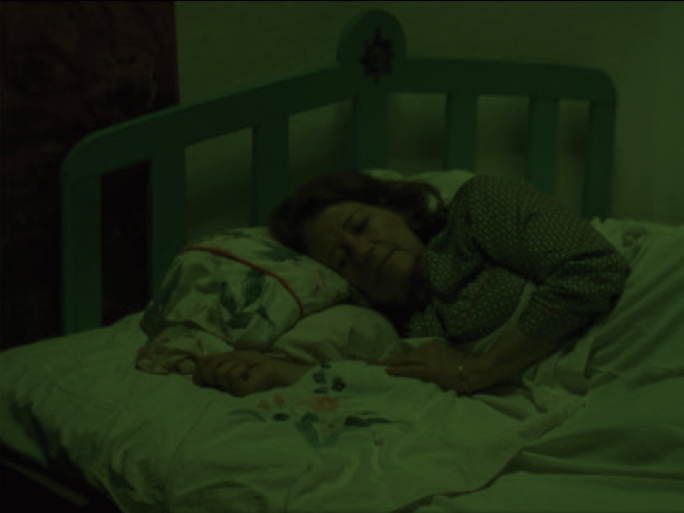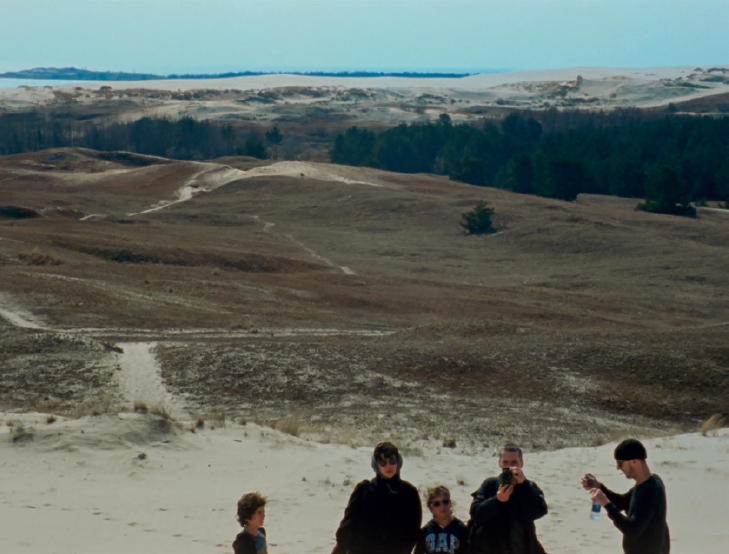Reshaping the Nuclear Family: Rosalind Nashashibi // Deep Redder
by Fanny Hauser

The visual language of Rosalind Nashashibi’s film works evades easy categorization, shifting between observational documentary and poetic subjectivity. Oftentimes elusive and eerily slow-paced, her films inquire into familial, societal, and systemic relationships between people, alongside the secret life of objects, the mechanisms of kinship, and everyday rituals performed within various social groups. Rather than documenting reality in an anthropological manner, Nashashibi’s 16mm films blur reality and fiction, exploring the passage of time and the ways humans organize themselves into communities or are organized by institutional structures. Coinciding with her solo exhibition DEEP REDDER at the Secession in Vienna, Staff Writer Fanny Hauser spoke to the artist about her most recent artistic collaborations as means to question and reshape the concept of the nuclear family.
Fanny Hauser: In your current exhibition at Secession, you are presenting a new film in two parts, which explores forms of communal life and the affective potential of relations in today’s society. The writing of Ursula K. Le Guin is an inspiration for your film, in which a multigenerational group of people are brought together to test a novel form of space travel that shuns the idea of linear time. Do you see a relation between nonlinear time and a new concept of family, beyond the traditional nuclear model?
Rosalind Nashashibi: Yes—Le Guin was a Sci-fi and fantasy writer, but she used those genres to look at what could become potential new models for society and family life, almost as an anthropologist of the future would. I was drawn to her treatment of a space crew in The Shobies’ Story (1990), because she explores the becoming of a functioning group, where strangers who are singles or in small families are brought together from diverse backgrounds and ages to spend a month building a crew mentality, before becoming test subjects of the new technology. The question the film asks is, how do we become a group to rebuild after a crisis? And what, therefore, are the productive or destructive moments ones in community?

FH: What is the crisis that you are referring to?
RN: In the film on view, entitled Part One: Where there is a joyous Mood, there a comrade will appear to share a glass of wine, and Part Two: The moon is nearly at the full. The team horse goes astray. (2019), the crisis is non-linearity—of time no longer obeying to the before, during, and after. Relationships may be built on two people’s history and they may be built on the notion of possession. In a way, these are very linear structures; there is a history to love, and there could be an end point. The end is expected in all but parental and some nuclear family relations. Love in a community is less finite and less linear, it does not necessarily move on, or attach to only one individual: a wider love. You could say it is an idealistic idea, but basically, the work discusses the potential difference between linear and non-linear relationships.
FH: How did you come up with the titles of the films?
RN: I consulted the I Ching, which is an ancient Chinese oracle. I threw coins while asking about this film and the beginning of the first shoot. These lines came from the response from Hexagram 61, Chung Fu–Inner Truth. I used these lines as principles from which to make the two parts. Part one is about being together and enjoying the group, part two is about the group fragmenting and then coming back together by means of storytelling.
FH: Fusing observational footage with staged scenes, your work is often characterized by documentary restraint and close observation of mundane events and nascent relations. Most of the time, you remain behind the camera as an observer. Knowing your earlier work, I was surprised by how constructed many of the scenes in the new work seem and, especially, to see you as one of the main protagonists of the film. Could you elaborate on this shift in your work?
RN: After the experience of making Vivian’s Garden (2017), particularly seeing how Vivian Suter and Elisabeth Wild manage family life alongside making their work, I decided to take down some of the boundaries between my life and my work—to let them feed one another directly. I felt I had to do so as a working, single mother, and I was ready to investigate how single parenting led to other relationships becoming more important to me. I do not believe in the sustainability of the nuclear family structure anymore—I am more interested in what happens when you open up to the participation of other people of all ages in family life. As for the constructed scenes, I have done that before, but they may have seemed ‘observed.’ In this case I wanted to ask more direct questions by using a sci-fi story line.
FH: Suter and Wild have also inspired you to start painting again—a medium very much opposed to the time-based medium of film, if we see these genres through a much older distinction between painting and poetry. How does the medium of your painterly work enter the subject matter of your film, or vice versa? And what comes first: the film or the paintings?
RN: They have definitely been an inspiration, but not to start painting. I started painting again in 2014, something I had wanted to do for some time, but put into action thanks to a Paul Hamlyn Award that gave me both the courage and funds to get a good studio and buy materials. In 2015, Adam Szymczyk introduced me to Suter, asking me to visit them in Panajachel and to see if I could make something there for Documenta 14.
There is no linear relationship between the paintings and film—they are two aspects of what I can make. In Part One, a painting of mine is held up by Elena Narbutaite, but the scene says more about my relationship with her and my painting than it does to relate painting to the medium of film.
FH: Can you say more about the soundtrack in the new films? Which song do we hear in Part II and how does it connect to the work?
RN: You hear Tu Virginum Corona from Exsultate Jubilate (1773) by Mozart. It is a song praising the Virgin Mary; I use it after Elena’s character is lost. When Pauline Manacorda and Liudvikas Buklys have given up on her returning to the lander, they stand facing, but are unable to look at one another. This song really captures their mutual feeling of loss and yearning, but also works as a metaphor for the huge emptiness of space itself. This scene is accompanied by the only representation of outer space in my film.
FH: You have often worked with other artists, but you have also used the life and work of artists as a point of departure of your films. Together with the artist Lucy Skaer, you have investigated the works of Paul Gauguin and Paul Nash. In your individual practice, the filmmaker Chantal Akerman has been a point of reference, but you have also filmed the artist Ren.e Levi in her studio and portrayed the life and relationship of Vivian Suter and her mother, Elisabeth Wild, themselves both artists. For your new film, you have been collaborating with the Lithuanian artist Elena Narbutaite, who also appears in your film. Some of her paintings are equally included in the book published in the context of the exhibition, juxtaposed on equal with your works. I feel this envisions an entirely different notion of collaboration, or even kinship. Could you elaborate a bit more on the notion of expanded authorship, the one based on such elective affinities?
RN: This refers again to my decision to open up my practice to various influences in my life—that includes both my family and friends. I find Elena to be a particular influence that inspires and catalyzes things to happen. She helps me to allow stuff to happen, or just be, if it needs to. We have worked together a few times and keep up a regular conversation. Her way of thinking and living is integral to the film; she is at the heart of it. So, like Vivian’s Garden in a way, the film is also led by a character.
I love collaborating as an extension of friendship and conversation, and an admission of the huge influence certain people can have on me, which is also how Lucy Skaer and I have been working as Nashashibi/Skaer sporadically for the last fifteen years.
FH: Can we expect a third part of the film?
RN: It is possible!
Rosalind Nashashibi (b. 1973 Croydon, UK) is a London-based artist working in film and painting. She studied at Sheffield Hallam University and Glasgow School of Art. Her films convey inner experiences of moments and events, often considering the politics of relations in the community and the extended family; while merging everyday observations with fictional or mythological elements. Like her films, her paintings move between impressions or “thought shapes” (to borrow the title of NashashibiÅLs 2004 series of screen prints) and more concrete depiction of forms or figures, while the figuration may be an imported element from another linguistic order. Nashashibi was a Turner Prize nominee in 2017, represented Scotland in the 52nd Venice Biennale, and her work has been included in Documenta 14 (Athens and Kassel, 2017), 10th Sharjah Biennial–Universes in Universe (2010), and Manifesta 7 (Trentino–Alto Adige, 2008), and MOMENTUM10–The Nordic Triennial of Contemporary Art–The Emotional Exhibition (Moss, Norway, 2019). She was the first woman to win the Beck’s Futures prize in 2003 and was recipient of Paul Hamlyn Foundation Award in 2014. She is a Senior Lecturer in Fine Art at Goldsmiths University.
Rosalind Nashashibi: DEEP REDDER at Secession ran from June 27–September 1, 2019.